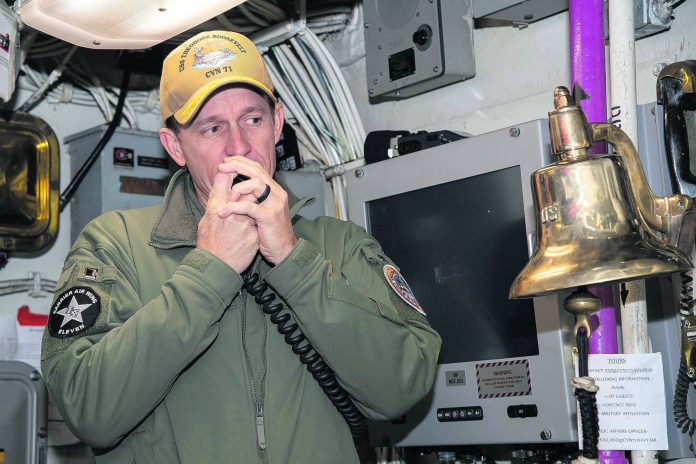
In a stunning reversal, the Navy has upheld the firing of the aircraft carrier captain who urged faster action to protect his crew from a coronavirus outbreak, the Navy’s top officer said Friday.
Adm. Mike Gilday, the chief of naval operations, also extended the blame for the ship’s pandemic crisis, delaying the promotion of the one-star admiral who was also onboard the USS Theodore Roosevelt — concluding that both men made serious errors in judgment. Less than two months ago, Gilday had recommended that Capt. Brett E. Crozier be restored to command of the Roosevelt.
The spread of the coronavirus aboard the carrier while on deployment in the Pacific in March exploded into one of the biggest military leadership crises of recent years. More than 1,000 members of the crew eventually became infected, and one sailor died. The ship was sidelined for weeks at Guam but recently returned to duty. The acting Navy secretary at the time, Thomas Modly, resigned in April over his handling of the crisis.
In summarizing his findings, Gilday told a Pentagon news conference that Crozier, as the ship’s skipper, and Crozier’s immediate boss, Rear Adm. Stuart Baker, “failed to tackle the problem head on and take charge,” as the virus spread throughout the ship, and their actions “fell well short of what we expect” of those in command.
“They did not do enough, soon enough,” Gilday said.
Gilday’s decision to hold both Crozier and Baker accountable is confirmation of concerns expressed by top Pentagon officials who demanded a deeper investigation when the Navy presented the results of a preliminary probe in April. On the basis of that initial probe, Gilday recommended that Crozier be restored to command of the Roosevelt. That move was not acted upon, however, pending the outcome of the deeper investigation released Friday.
“Had I known then what I know today, I would have relieved him” of command in April, Gilday said.
Navy Secretary Kenneth Braithwaite, who took office after the deeper probe was begun, told the news conference that “emotions got in the way” of determining the full story of what happened aboard the Roosevelt, resulting in a too-narrow initial investigation. He said there had been “a rush to judgment,” but he did not say who he blamed for that.
Among other findings, as described by Gilday, the investigation determined that the likely source of the coronavirus infection was obtained during a port visit in Vietnam in March. He said investigators were unable to determine who among the crew was the first person to be infected.
The investigation, done by Adm. Robert Burke and endorsed Friday by Gilday, found that Crozier failed to stem the outbreak or properly communicate the escalating crisis to senior commanders. It also concludes that the ship’s slow response to the virus was not his fault alone, and that Baker also failed to take decisive actions to address the problem.
Gilday’s recommendations cap a drama that has engulfed the Navy for nearly three months, sidelining the carrier for 10 weeks in Guam, and setting off a dramatic series of events that led to Crozier’s dismissal, the abrupt resignation of the acting Navy secretary who fired him and the push for a broader review of the Pacific fleet’s top commanders and how they handled the virus outbreak.
Based on the findings, Crozier and Baker would be able to remain in the Navy and move on to other jobs at their current rank, but the admonishments are likely career-enders for both men. Gilday said Crozier will not be eligible for command again.
Crozier’s firing upset the carrier’s crew at the time, and he received cheers and applause as he walked off the ship. Gilday said Friday that in several instances he believes Crozier put the crew’s comfort ahead of its safety. He said the commanders were slow to move the sailors off the ship and released sailors from quarantine in one area of the ship too quickly.
Braithwaite, the Navy secretary, told a Senate committee in early May that the service was in “rough waters” and suffering from leadership failures.
The COVID-19 outbreak on the Roosevelt was the most extensive and concentrated spread of the virus across the U.S. military. It eventually sent all of the 4,800 crew members ashore for weeks of quarantine, in a systematic progression that kept enough sailors on the ship to keep it secure and running.
More broadly, it put out of commission a massive warship vital to the Navy’s mission of countering China’s power in the Asia-Pacific region.
When the coronavirus outbreak was discovered on the Roosevelt, Crozier sent an email to several commanders pleading for more urgent Navy action, including the removal of nearly all sailors from the ship to protect their health. That email was leaked to the media, and Modly accused Crozier of bad judgment and directed that he be relieved of command April 2.
Days later, amid an uproar of his handling of the matter, Modly resigned and was replaced by James McPherson. Braithwaite’s nomination to be secretary was still pending at the time. He took over earlier this month after he was confirmed by the Senate. In the report Friday, Gilday concluded that Crozier did not intentionally leak the email.
The Roosevelt, meanwhile, spent weeks in port in Guam, as crew members rotated ashore for quarantine and isolation at the military base and in hotels around the island. After about two weeks of training at sea, the carrier returned to operations at sea with a reduced crew on June 4. Sailors have continued to fly back to the ship from Guam after they have recovered from the virus or completed two weeks of quarantine.
The Roosevelt’s experience with the virus, however, spurred the development of widespread cleaning and health precautions across the military. And it also gave federal health authorities a population of sailors to test, providing greater insight into the science and the spread of the virus.



















